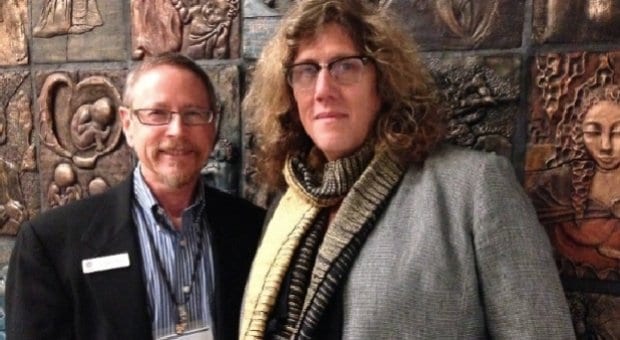Scholars from colleges, universities and community organizations across North America and all over the world converged on Vancouver Island March 21 to 23 to attend the first-ever conference on accessing and archiving trans history.
The event, titled Moving Trans* History Forward, was held at the University of Victoria, home of the world’s largest trans archives. Topics addressed included the possibilities of digital collections, crowd-sourcing materials and the exclusions inherent in the organization of traditional archives.
Michael Waldman, head librarian at New York’s Baruch College, highlighted the power archivists, such as those at the Library of Congress, have to shape the recording of history through the categories they use to file information. A telling example is the materials that pertain to homosexuality, long filed under the heading of sexual deviance.
“Information organization is always transmitting an ideology,” Waldman noted.
Conference organizer Dr Aaron Devor said that, in addition to finding material, one of the key challenges of building archives like this has to do with scope. “What do we include? Where are the limits of this community? Who counts as transgender for the purposes of transgender archives? We’re trying to be as broad in that understanding as we can be,” he said. “There were, and will be, records of people who wouldn’t necessarily call themselves transgender, but we include them in the gender-variant community.”
Devor, originally a sociology professor, has been the dean of graduate studies at the University of Victoria for the last 10 years and has been building the archives for almost as long. The first conversation took place in 2005, and the archives received its first donation in 2007.
Devor has devoted the better part of the last two years getting the collection to where it is now.
The theme of searching for what has been left out of historical narratives, in addition to what was included, emerged throughout the conference.
Ms Bob Davis, a music teacher and transgender outreach coordinator from City College of San Francisco, brought a sampling of her extensive collection of photographs to discuss cues researchers can use to identify archival images of trans people when they aren’t tagged as such.
To distinguish between crossdressing and possible transgender identity, Davis said, she looks for things like the fit of the clothes and the setting, attention to grooming and instances of the same person appearing in different outfits on different occasions, indicating their clothing choices might have more to do with gender identity than with theatricality or entertainment.
Her favourite photo is one she believes depicts a person with a trans identity. The subject is wearing a well-fitted black dress and long necklace, and the hair is pulled neatly back. It was taken in a professional setting, with the person resting an arm demurely on a tall stool with a bouquet of flowers set on the floor. But the most telling part is the space between the person’s arms and torso, showing bright white instead of the woodsy pattern of the background. Davis explained, “She took watercolour — I believe it was watercolour — and painted herself a more feminine figure. The clothes weren’t enough.”
Dr Sara Davidmann, an artist and researcher working at London’s University of the Arts, used old photos from her own family album to uncover the history others in her family tried to hide. After learning the long-held family secret that the person she had known as her Uncle Ken was trans, Davidmann found letters about Ken between her mother and her aunt, Ken’s wife Hazel, in an envelope that had the words “Ken. To be destroyed” handwritten on it. The letters described a person and a life Davidmann had never known about, and she used them to reframe her uncle as the person he was rather than the person the family wanted him to be. She used the words on the envelope as the title for the project.
Using the information in the letters about Ken’s gender and presentation — things like the platinum blonde wig he wore — Davidmann used both old and new techniques to modify the only photos of Ken in the family photo album (those that present him as male) to reflect his trans-ness, “reinstating him as trans” in the album and, consequently, in the history of the family.
“They’re really fictions,” she said of family photo albums, adding that, like any archive, they can be used to erase people and stories. “The photographs were taken at birthdays, wedding celebrations, holidays. They weren’t taken at any of the situations where there might have been conflict or difficulties or problems.”
Dr Susan Stryker, co-founder of a new journal called Transgender Studies Quarterly, to be published through Duke University Press, and catalyst behind the highly anticipated new graduate degree program in transgender studies at the University of Arizona, gave the keynote speech March 22.
Devor says this symposium is necessary to link people who have been studying trans issues all over the continent, many of them in relative isolation. He says there’s no substitute for the company of other scholars grappling with the same issues.
“The benefit of bringing together people who, by virtue of being together, come up with whole new ideas about what to do, is that you get synergies, you get more than the sum of your parts,” he said. “It’s wonderful to see it happen.”
When he began planning, Devor said, he didn’t give a thought to the future of the conference, but almost as soon as he started telling people about it, many said they couldn’t make it this year, but they’d definitely come to the next one.
“Many people keep saying they’re looking forward to the next one. Everybody just assumes there’ll be a next one, so I think there’ll be a next one,” he said with a smile.

 Why you can trust Xtra
Why you can trust Xtra


